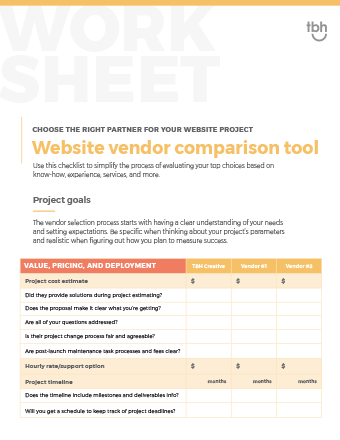
Whether you’re starting a website project from scratch or working toward a redesign, deciding on the best approach can be tough. Can you do the work yourself? Should you use a template? What level of service do you really need?
Let’s take some of the guesswork out of web design. We’ll establish a baseline, then help you evaluate examples of web design packages so you can confidently plan a project that will meet your needs and help you fulfill your digital goals.
Let’s take some of the guesswork out of web design. We’ll establish a baseline, then help you evaluate examples of web design packages so you can confidently plan a project that will meet your needs and help you fulfill your digital goals.
Collect the building blocks.
In order to launch a website, you need some basic details. If you’re building a brand new website, it may take time to initiate and compile these items, and with a redesign you may need to track down access. As you go, keep track of the details in a secure access document.General website information:
- Domain – Which URLs do you currently own, and do you need to purchase and/or redirect others? Who is your registrar provider? Is the domain your company’s name and do you have access?
- Hosting – Where is your current website hosted? Does it have a dashboard interface? Are there any IT considerations on hosting as you work towards a redesign project?
- Content management system – Are you happy with the management options of your current website? Is it easy for you to edit or make changes? Anything you like specifically or wish was different or easier?
- Analytics – Do you know how much traffic your current site has? Are you tracking the right information and analyzing stats on how the different pages on your site perform?
- Access – Do you or someone on your team have technical level access, such as FTP or database? What other components require logins and do you have all of that information available?
- Third party integrations – Are there any tools you use on the site, such as a shopping cart, form builder, or email management that require access for integration?
- Previous agency/website builder information – What is the background story of your current site? Are you currently working with a partner for website management? Are they going to be a part of the transition and new project? Have you told them you are switching to a new provider? Will they provide working files or full access if you plan to redesign an existing site?
Consider your needs.
Next, get a big picture overview of what you’re trying to accomplish with your project. Having an idea of where you are and where you’d like to be can help you evaluate web design options more easily. Depending on your time and scope, you might want to conduct a site audit and/or create a complete website strategy or project blueprint. But even if you’re up against a tight deadline, taking a few minutes to think through your goals will save you substantial time and resources during your website project.Compare examples of website packages.
What’s the best and most efficient way to achieve the goals and meet the needs you uncovered during your website audit? Should you take a DIY approach? Use a website template? Hire a full-service digital marketing agency? As you might imagine, there are pros and cons to every approach.
Download the Website Vendor Comparison Tool. Use this checklist to simplify the process of evaluating your top web company choices—plus questions to ask.
Download now
Download now
- Do-it-yourself website design
- Freelancer or small web team
- Professional website company
- Full-service agency
1
With a What You See Is What You Get (WYSIWYG) service, the pros are also the cons. Although it’s cheaper up-front, you may find that the time and opportunity costs of a DIY option make it less cost-effective than expected.Do-it-yourself website design
Pros
Template solutions like Squarespace and Wix offer pre-defined website templates. Add your own content and images to get a website up and running with a few clicks.Cons
Do-it-yourself website templates are ‘easy’ technically, but they leave many other steps up to you to ensure success. You may find a message board to help you troubleshoot issues or questions, but ultimately you’re on your own to figure out a solution. Visual customization, functionality, tool integration, and search engine optimization options may be limited, and will require significant time to create, implement, and test.Considerations
For photo editing on the web, you will need software or online tools to edit, compress, and otherwise prepare your photos to be used on the website.
“Two seconds is the threshold for ecommerce website acceptability. At Google, we aim for under a half second.” Maile Ohye, Google
2
Freelancer or small web teamIf you hire a freelancer or designate an employee with web design and development experience to partially customize a template or add some custom-coding, you’ll gain support, but may find substantial pricing, timing, and quality variations.Freelancer or small web team
Pros
There is always an advantage to working with experienced individuals, so you’re likely to have more support with common troubleshooting issues than in the DIY example above. If working in-house or keeping the designer on retainer, you’ll have a go-to website manager who can help to make edits or updates as you need to make changes to the website content.Cons
Variations in service and quality are difficult to factor in when you go this route. You will likely be using the designer’s preferred platforms and third-party services, regardless of how they might fit with your business goals for the website. If the website is a custom design, a freelancer may even hardcode the site without the back-end modularization that allows you to easily make edits without advanced coding knowledge. He or she may excel in one area but not have expertise in another. Building an effective website requires a team with a multitude of different skills.To avoid major pitfalls with basic web design packages, make sure all skills are covered to be successful and understand what is included in an hourly rate.
Considerations
3
Professional website design services include responsive website coding, designs tailored to your company and content, and best practices for your audience and industry. A professional web design company adds value and offers expertise to your project.Professional website company
Pros
Trusting your website design to a professional, experienced company gives you a wider range of expertise and a more strategic web solution. Web design agencies build websites all day, everyday. They have experience with current website trends and best practices and multiple team members with a variety of skills to put into the project, including development, content planning/writing, SEO, scalability, custom functionality, and professional design/UX.Cons
The biggest risk in a pro website package is the selection process. Be sure to thoroughly vet agencies to be sure they are actually professionals and that they will be a good fit for your organization. Like any other industry, some companies are more experienced than others or provide better options for specific needs and website designs.A professional website company will require a larger investment than do-it-yourself or freelancer options.
Considerations
More answers to common website design questions
4
Working with a full-service digital marketing agency makes sense for businesses that need a strategic new website that effectively reaches their target audiences and meets their business goals. A successful web strategy doesn’t end when the website launched. The best websites require ongoing improvements through marketing campaigns, ads and promotions, keyword research for website content and blog articles, email marketing, social media management, and other integrated marketing services.Full-service digital marketing agency
Pros
With a marketing agency partner, you’re getting a holistic, full-service approach to your digital marketing. The website will be an integral part of all digital marketing initiatives and digital success.Think strategic planning.
Think persona research.
Think professional writing.
Think return on investment.
Then, think beyond the initial custom website design to ongoing support, integrated marketing, and strategic analysis to make sure you continue to see results.
Cons
Full-service agencies differ widely in personality and approach. Multiple agencies may have the experience and expertise you need, but that doesn’t necessarily mean they will meld well with your company’s culture and way of doing business. Be sure to look carefully at compatibility as well as capability when you select a vendor.The support, guidance, and expertise of an experienced marketing agency will require an investment higher than other project-based solutions. However, good marketing works. If you consider your savings in employee time and company resources, combined with the value of the additional leads and ongoing monitoring and improvement that you get from high-level design and marketing, your savings plus added value will offset the costs over time.
Considerations
For example, if your website costs $80,000 to launch and $500/month to maintain, but brings in revenue of $150,000 in online sales, you’ve more than offset your initial investment in the first year alone.
But what about businesses that don’t handle transactions online? How can you quantify results if there is no direct point of exchange happening through the website? In this case, think of your website as a member of your sales team working to nurture leads and build contacts for your sales team to close. The visuals, organization, and content of your site act as a touch point for getting new leads, shortening the sales cycle, and building brand loyalty. What is the value of your brand? Can you afford not to have a high-quality website representing you online?
Choose the right level of service to make your new website a success.
As you look at examples of web design packages, consider more than the bottom line on the website invoice.- Does your team have the capacity and expertise for DIY web design?
- What level of design and functionality do you need to meet your goals?
- Can you integrate other marketing services to help you reach your objectives and increase your overall ROI?
Need help with your digital marketing strategy? Not sure if you’re ready for a full-service agency?
Let’s talk about the solutions that make the most sense for you
